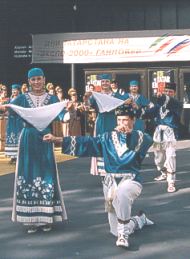Music
 | |
All variety of Tatar musical folklore can be divided into vocal and instrumental music. The song mirrors the emotional life of the people - sorrows and joys, holidays and customs, life and historical development. Tatar songs include ceremonial (calendar, wedding), historical (bayits) and lyrical songs. Only solo singing developed in national musical art.
Ancient songs and folklore dances of girls with their plasticity and grace, shy movements, lack any wild outbursts, vim or vigor. Monotonous movements with small steps almost on the same spot in the national Tatar dance as well as drawling sad songs signify to the decent secluded life of Muslim girls.
 | |
| Salih Saidashev |
Spiritual music was part of musical culture. Islam, as official religion, influenced not only culture as a whole, but also development of musical art. Koran itself does not directly prohibit music, it is present in the Muslim cult, helping believers to comprehend the contents of the sacred book of the Muslims - Koran recited with a singing accent. The melodies of surahs were orally passed from generation to generation within the walls of religious educational institutions.
Professional Tatar music and composer school were formed in the middle of our century. S.Saidashev, N.Zhiganov, M.Muzafarov, D.Faizi created a new original style combining national traditions and forms and genres of European professional music.